Invasive Pests
Introduction
What’s bugging our St. George peninsula?
It’s not just invasive plants, our state and our town continue to see new threats to our native fauna and flora. Fortunately, the state tracks outbreaks and provides residents with important ways to identify and contain them.
Here, we want to highlight just a few of the most critical bugs where we have the advantage of still limiting their spread.
Browntail Moth
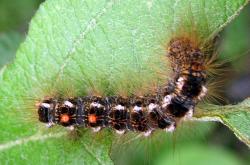
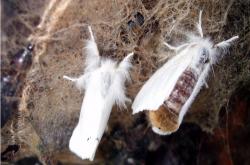
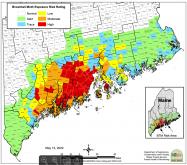
The Browntail Moth was brought to Massachusetts from Europe in the 1800’s. Over the last several years however, the moth has become a significant pest for the mid-coast region of Maine. The primary impact on humans results from contact with poisonous hairs produced by the caterpillars. Microscopic, toxic hairs break off the caterpillars and can be airborne or settled on surfaces in Browntail Moth infested areas. Sensitive individuals who encounter the hairs may develop a skin rash similar to poison ivy and/or trouble breathing. Symptoms can last anywhere from a few hours to several weeks and can be severe in some individuals. The hairs on the adult moth are not toxic.
One of the best ways to contain the Browntail Moth is to locate and destroy their winter nests. The website below from the Maine Forest Service provides a video on how to spot and identify the nests and how to dispose of them. It also gives you specific information on how to identify the moth and most importantly, the caterpillar that has the toxic hair. Click here
Tools and Tips for Helping To Knock Out More Browntail Moths
Know the Four Rs to Reduce BTM populations in Maine
Recognize BTM winter webs in the trees where you live, work, or play. Knowing where BTM winter webs are in your yard or town can help inform your management decisions and aid in removal to prevent impacts from the toxic hairs.
Remove BTM webs with hand snips or an extendable pole pruner in areas within reach of the ground and away from hazards such as powerlines. Protect your eyes and skin from hairs that might be present from past caterpillar activity. After removal, destroy the webs.
Recruit professional help to treat BTM webs out of reach or near hazards on the property you own or manage. Licensed professional arborists can remove BTM webs in larger trees and shrubs in the winter. Some arborists offer web-clipping services using drones. Licensed pesticide applicators may be able to help control BTM adult breeding activities during the growing season.
Reach out if you have concerns about BTM. Neighbors, business owners, and community members can come together to respond to the problem and achieve greater results. Consider hosting your own BTM web clipping event in your neighborhood to reduce the itch for your family and your community!
For More Inforamtion:
Beech Leaf Disease
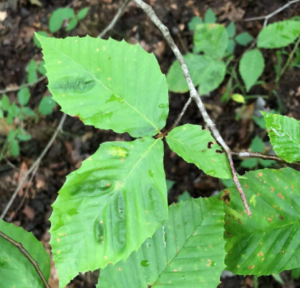
A fairly recent invasive is spreading in our region. Beech Leaf Disease was first detected in Lincolnville in 2021. Signs of the disease have been found in towns from Belfast to Rockport and inland to Searsmont and Hope. The disease was first recorded in Ohio in 2012. Origin is unconfirmed.
A microscopic roundworm as been consistently associated with symptoms, but its role in the disease process in not fully understood. While mature beech trees are less often affected, they can be significantly stressed. The biggest impact is on understory beech which can be severley damaged leading to tree death in 3-5 years.
Symptoms of the disease include:
- Dark bands between the veins of leaves.
- Leaves become curled, deformed, and shriveled.
- Trees develop a thin canopy
The Main Forest Service is asking for help identifying additional areas impacted. Call (207) 287-2431 or click here.
Emerald Ash Borer
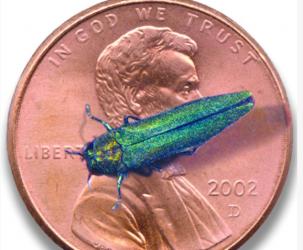
The Emerald Ash Borer (EAB), is a small beetle that is killing our ash trees. It was first found in southeastern Michigan and has since been spread primarily by the movement of invested firewood across the states. In Maine it is currently found in York, Cumberland, Oxford, and Aroostook counties but is continuing to spread. If not stopped it has the potential of wiping out our ash trees. The main thing we can all do is to not transport our firewood to different locations and to let our friends and neighbors know as well. The state is actively monitoring for this beetle.
- Click here to see a map of current locations
- If you suspect an infected tree, please click here to notify the state
- For more information on identifying the EAB, click here for a USDA website that provides great visual information
Spotted Lanternfly and Tree of Heaven
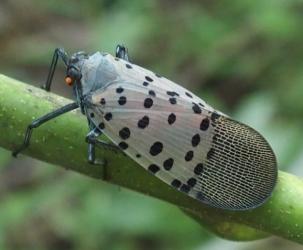
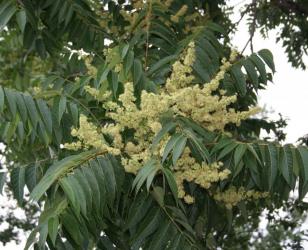
Here is an interesting situation. The Spotted Lanternfly has not been found in Maine but is spreading rapidly. It comes from Asia and is heavily associated with the Tree of Heaven which is an invasive species itself and found throughout the states. The State of Maine is asking us to be on the lookout for the Tree of Heaven and report any sightings to them which they will then monitor for the Lanternfly.
- Click here for a link to identifying the Tree of Heaven
- To report sightings of the Tree of Heaven in Maine: email invasives.mnap@maine.gov
- If you want to learn more about the Spotted Lanternfly, click here for an entertaining and short video on everything you may want to know including how to get rid of these critters:
Hemlock Wooly Adelgid
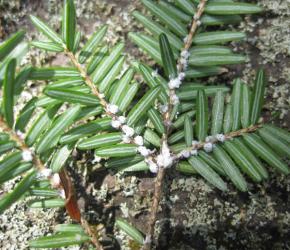
The Hemlock Wooly Adelgid is a small aphid-like insects that is found on the underside of hemlock needles. It appears as wooly klump. It is present in Maine and continues to spread. Heavy infestations will kill the tree in 3-6 years. If you have Hemlock on your property check the needles at the ends of branches. If the adelgid are present there are methods for saving tree including root injections from an arborist.
For More Information:
- Click here for a website that gives you detailed information along with a map of the adelgid presence in Maine
- Hemlock Wooly Adelgid Fact Sheet
Asian Longhorned Beetle
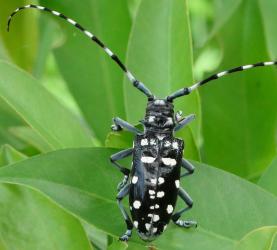
The Asian Longhorned Beetle (ALB) is a threat to America's hardwood trees. With no current cure, early identification and eradication are critical to its control. Although not yet in Maine it is currently found in Massachusetts, New York and Ohio. The ALB has the potential to cause more damage than Dutch elm disease, chestnut blight and gypsy moths combined, destroying millions of acres of America's treasured hardwoods, including national forests and backyard trees.
